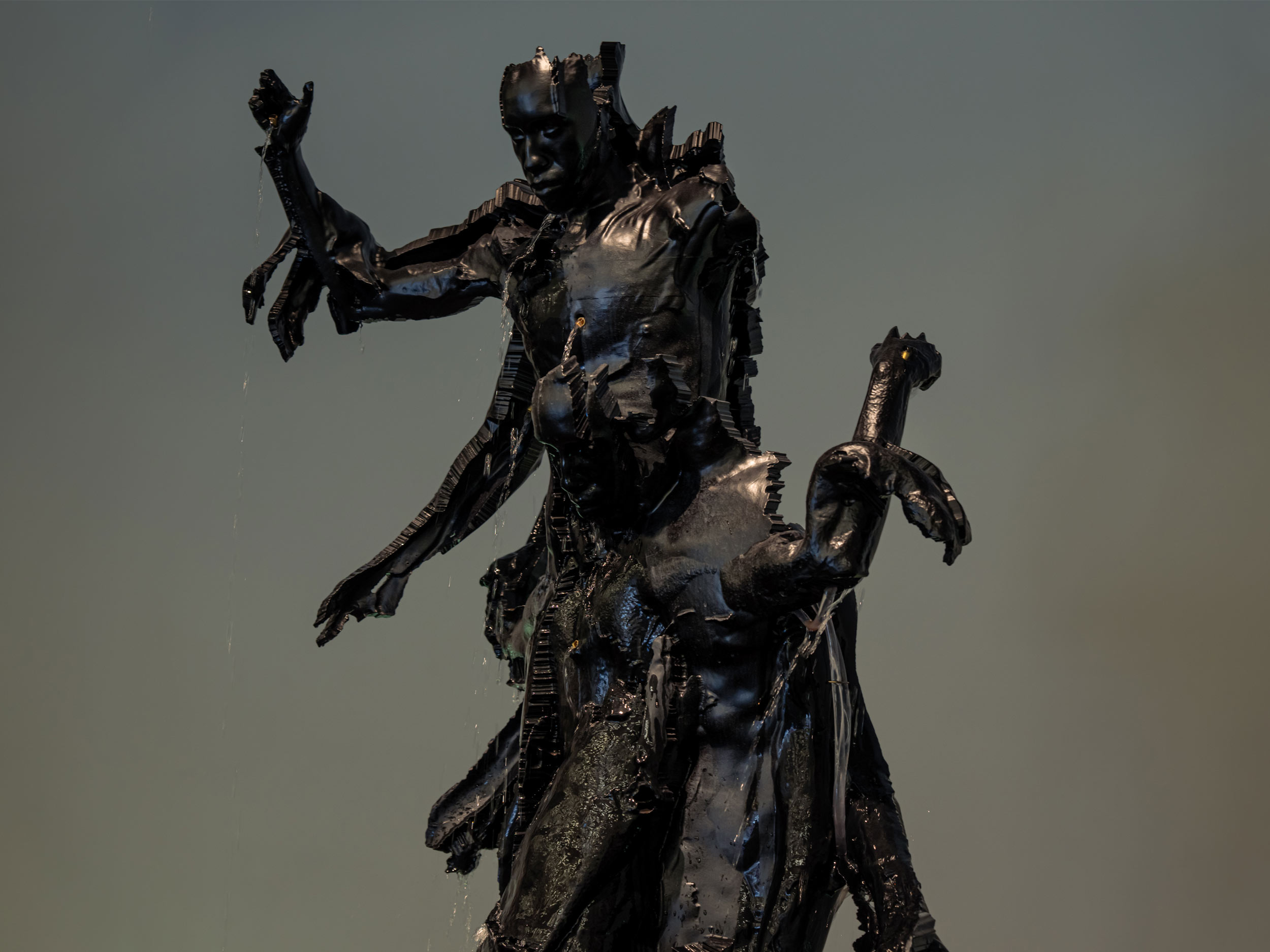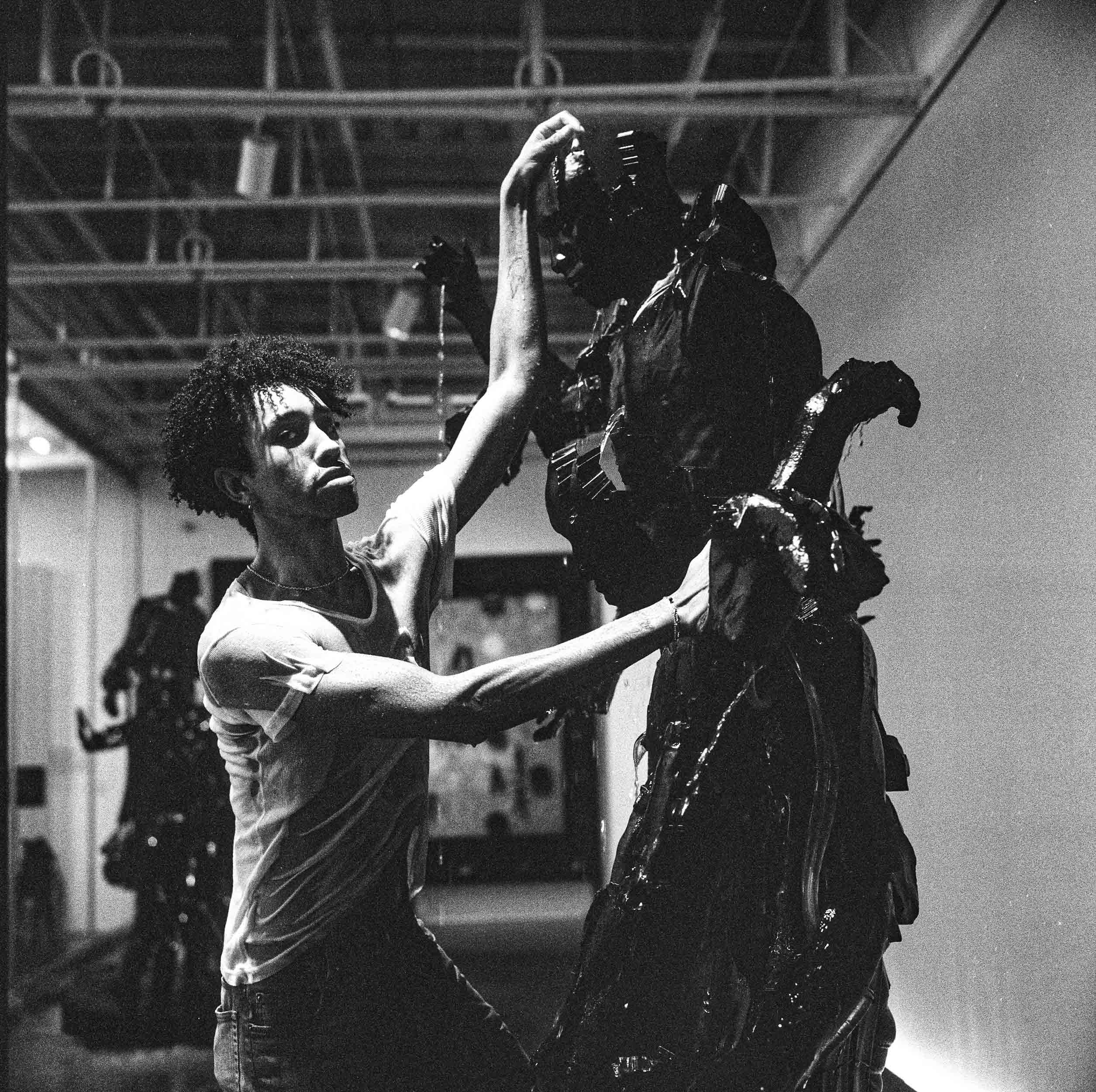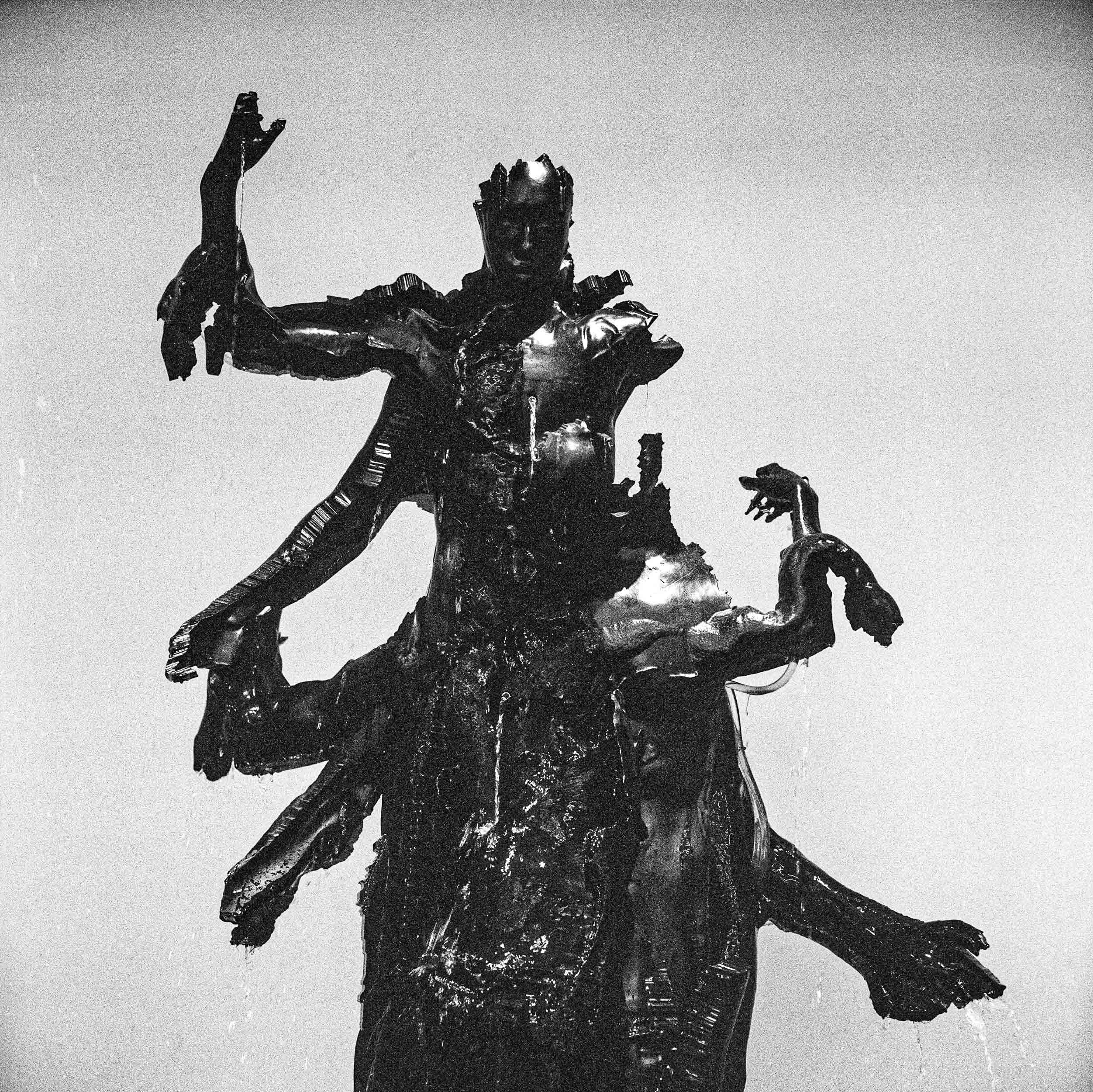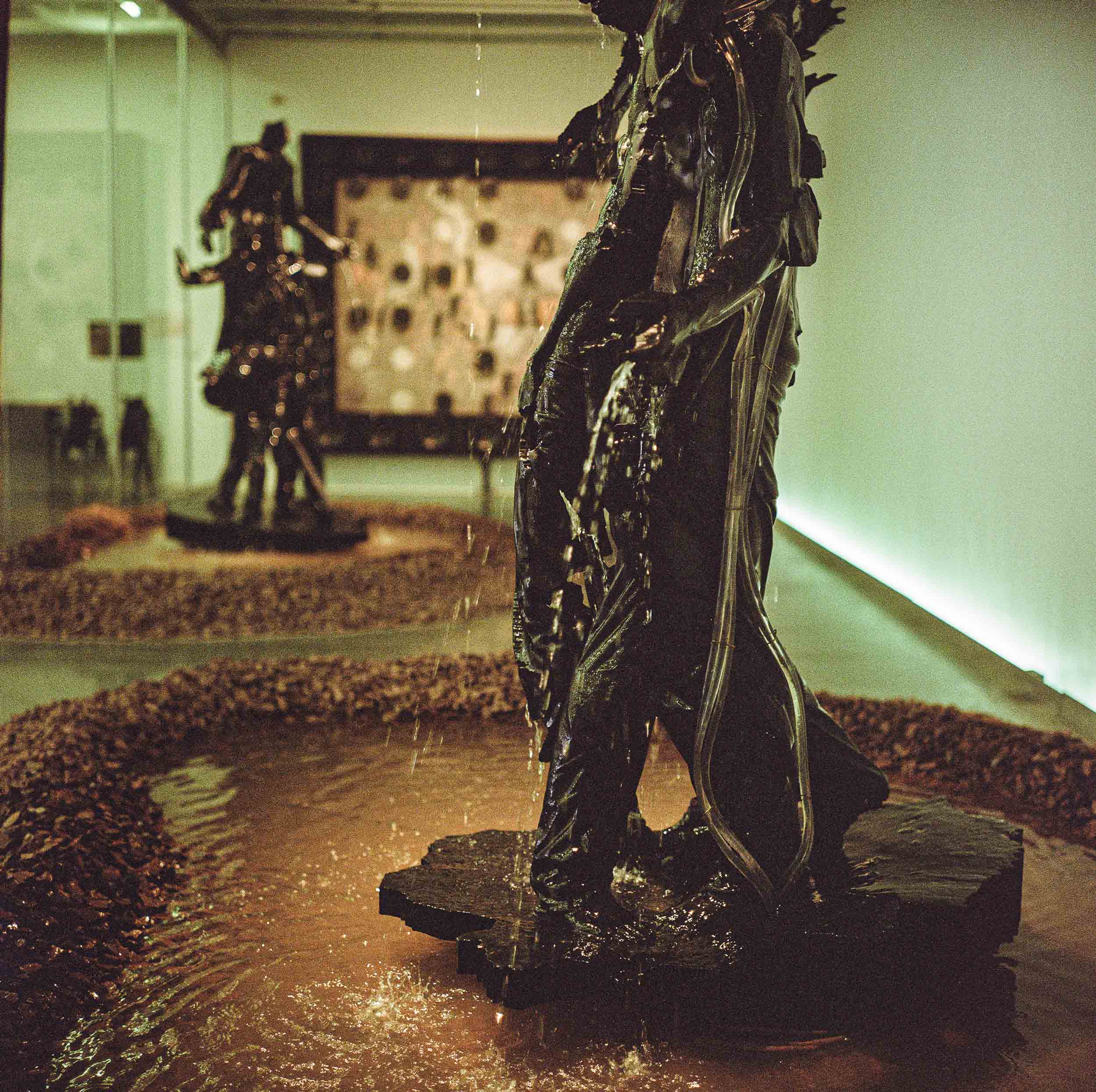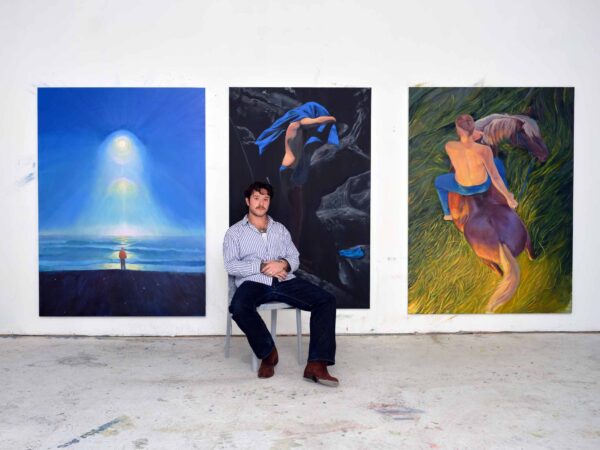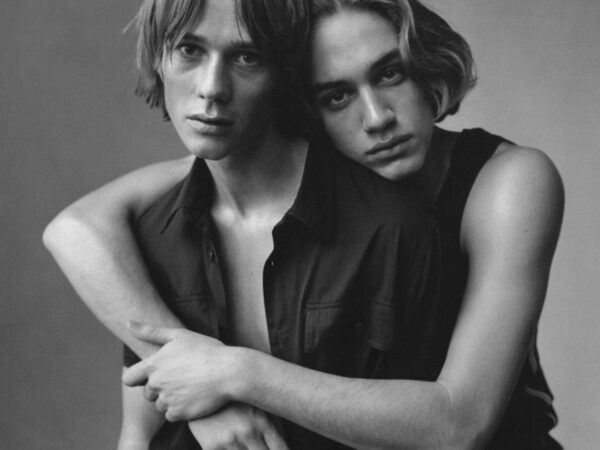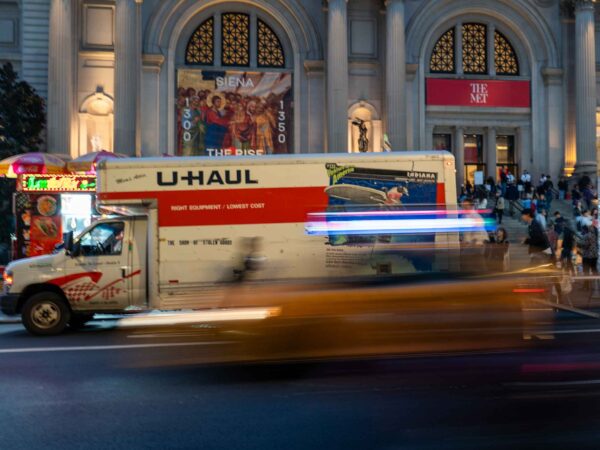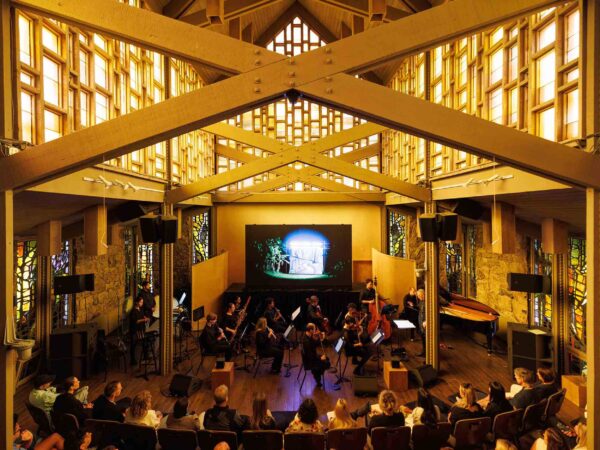The artist’s latest exhibition departs from durational performance into the world of sculpture, shifting from the hyper-present to a figurative temporality
Last Monday was long for Miles Greenberg, a continuation of the intensity of the trying week prior. He had rushed back to his Lower East Side apartment to hop on our call, still jittery from a jam-packed day. Periodically plunging a tea bag into his mug, his posture softened as he delightfully recounted the opening of his exhibition at the New Museum—which was also the source of his fatigue. But now, he has a newfound enthusiasm: “Being able to say, ‘It’s up until February’ is so radical to me, because usually I have to give people a time window” he says, noting that the sculptures showcased in The Shadow of Spring represent a departure from his durational performance work.
At 17, Greenberg departed from institutional learning, instead finding mentors in world-renowned performance and theater artists, like Marina Abramović and Robert Wilson. Most known for enacting “live” performances that confront the physical limits of his body, Greenberg repeatedly engages with self-imposed spatial and temporal constraints. In Oysterknife (2020), produced by the Marina Abramović Institute, he walked on a conveyor belt uninterrupted for 24 hours, with the exception of a 23-minute loss of consciousness at hour 18; in Hæmotherapy I (2019), he balanced a water-filling vessel on top of his head, standing atop an altar of raw meat and spices as a ritualistic, culinary, and olfactory proposition for seven consecutive hours; in Pneumotherapy II (2020), he similarly perched on an elevated pedestal for seven hours straight, beneath a bed of liquid that slowly trickled on to his skin—a ceremonial gesture informed by both scientific and spiritual interpretations of the human body, with reference to the metaphysics of internal mechanisms. Thus far, his career’s trajectory has not lost traction; this past week, Greenberg was announced as a member of Forbes’s “30 Under 30” Class of 2023.
Departing from his endurance-driven performative practice, The Shadow of Spring showcases Greenberg’s foray into sculpture. The explicit confrontation of emotional intensity against his body has shifted from the durational, hyper-present to a symbolic, metaphorical temporality in a series of large-scale, shiny, black figurative sculptures made from urethane, steel, and enamel, which are displayed in the New Museum’s lobby. Surrounded by water basins, the sculptures double as fountains, water trickling down from their orifices. The exhibition is a collaborative effort between Greenberg and Brazilian artist Vivian Caccuri. They were introduced by the curator, Bernardo Mosqueira, and in turn, they birthed a new universe, a “mutual planet” that united their practices. The exhibited works, though constructed separately, palpably engage in atmospheric dialogue. Greenberg’s sculptures are modeled after three-dimensional, digital scans of his body during his 2022 performance in Fountain I, where he stood on top of a white plinth that hovered over a large pond of “blood,” while a viscose, orange liquid oozed from his hands and chest into the reservoir below. In an asymmetric array, the obsidian sculptures pilot the viewer’s gaze to the gallery’s innermost wall, from which Caccuri’s tapestry hangs. The piece features embroidered figures sewn on a transparent woven screen, suspended atop a thicker taupe fabric, creating a dimensional, moiré effect that is echoed by its unusual rectangular frame: a four-corner structural outline of car stereos. The stereos echo the melodies of guts, hearts, and lungs—a soundtrack made from both the artists’ internal organs, as recorded by a digital stethoscope. “[Vivan]’s tapestry—in the way that I see it—recounts the mythology or the lore behind this planet, and my figures are the inhabitants of this universe,” Miles explained, “She measured my heartbeat, [and we] whispered in each other’s subconscious.”
In conversation with Document, Greenberg reflects on his venture into sculpture, the dichotomy of bodily movement and decay, and the humorous and sublime nature of mortality.
Yuki Xu: The second law of thermodynamics says that entropy always increases with time. In your experience, is that true?
Miles Greenberg: Yes.
Yuki: Do you want to expand?
Miles: I kind of just want to leave it at that [laughs]. Well, when I make work, there’s a delicate balance between [my] intention and what is physically possible. The dichotomy is between the forms that I’m imagining and the forms that my body is able to withstand. The magic of an artwork is in the discrepancy between those two points—I love to create and then see how far it departs from the original intention. For example, in Oysterknife (2020), the intention was to only walk, and it unexpectedly turned into a strange movement piece, where the shape of my body changed from being upright to a crouched posture. I also fainted. You could identify the parts of my body that were being strained—you could map out gravity, and how it was acting on me.
Entropy, to me, is the decay of the form. I think what’s so fun about it is that the decay of bodily form is something that we are all intimately acquainted with—whether you are conscious of it or not.
Yuki: Water is a recurring element in your recent works. What stories or mythologies are behind that?
Miles: Years ago, Bob Wilson told me that space is horizontal, and time is vertical. I love working under constraints, or self-contained systems of logic. These hard barriers and definitions helped me develop my own artistic language. In Hæmotherapy I (2019), I came up with the idea of a drip coming from the ceiling as a way of measuring time. During the performance at Reena Spauling, I also had water drip continually into a vessel that was sitting on top of my head, filling up over time. Then, I performed another piece, Pneumotherapy II, in which I also had a drip coming from the ceiling, [but this time], the liquid dripped directly onto my body. I used cane sugar syrup, which is so viscous, sticky, slow, and shiny—and it stayed shiny on my body. I went from having a few droplets on me to being completely covered in a viscose, slow-moving, watery, oily, amniotic, mystery fluid. It gave a relationship to time that was legible, so that people could—in addition to the fatigue that my body created over time—have logical reference points of temporality.
In The Shadow of Spring, I love the basins’ ripples, the subtle vibrations that give away the smallest movements. When the performer is standing still in water, it amplifies the minutiae.
“Entropy, to me, is the decay of the form. I think what’s so fun about it is that the decay of bodily form is something that we are all intimately acquainted with—whether you are conscious of it or not.”
Yuki: I didn’t realize that in Fountain I (2021), your pants were originally white and not orange —they got dyed in the performative process.
Miles: At the end of Fountain I (2021), I didn’t realize that my skin was going to be thoroughly dyed. Everything was iodine to the max. I came out looking like Cheeto dust. All things considered, liquids have a real impact and a real connection to mythology as well as the body. The liquid form is mysterious and has a logic to it that’s rather non-form. I think it’s just so seductive, and it points at so many things that are happening inside of us.
Yuki: What was it like to record your internal liquids as a sonic exhibition piece for The Shadow of Spring?
Miles: Vivian led the composition of that work—the sonic tapestry. She’s a real musician; she had the idea to use a digital stethoscope. I’ve never worked on a soundtrack quite like this before. Usually, for music to accompany my art, I work with composers and collaborators, or I make my own soundtracks, but this is a very different approach because the body is my main focus. I always approach new media—media outside of my primary medium, the body—in the same way. If I’m doing a soundtrack, I’m going to compose it by thinking of it as a body; or if I’m editing a video, I’m going to think of it with the logic of human anatomy. The way that I compose anything is the way that I would compose a performance, emphasizing an oscillating, cyclical, never-ending structure and velocity.
Yuki: You are both strong world-builders. Vivian is a spatial composer, and you are a sculptor and performer of space and atmosphere.
Miles: It’s funny that you say that, because world-building is such an important touchstone for me. I was a video game nerd; part of my education was being a World of Warcraft kid.
Time and space operate differently in games—gravity falls at a different speed, so you have to acclimate yourself to the height at which you can jump, the speed at which you fall, the way that things move when you move. It sort of trained my brain to adapt to an environment that didn’t necessarily follow the rules for the rest of my life. It’s the kind of sensibility that I would like to train my audience to pick up when they walk through the door of one of my exhibitions. I want the laws of nature to suddenly shift, giving them an opportunity to discover themselves. You look at your own effect on the world around you and start to examine your own avatar’s corporeality. I always want people to go inwards in the way that I go inwards in my performances.
“It’s the kind of sensibility that I would like to train my audience to pick up when they walk through the door of one of my exhibitions. I want the laws of nature to suddenly shift, giving them an opportunity to discover themselves.”
Yuki: These avatars that you’re speaking of, is that how you think of your 3D scanned versions of yourself? Are they your avatars?
Miles: They are not necessarily me. I don’t have alter egos, but I’ve grown to see my off-stage self as different from my on-stage self. On-stage is a sensitive and violent character that was a vehicle through which I could tune in with a certain kind of emotional intensity. For Fountain I, I wanted to create a dramatic scenario at the end of a movie where somebody is dying in someone else’s arms, and there’s an overhead shot of screaming, “No!” I had a period where I was experiencing a lot of transitions, a lot of repeated intense emotional landscapes, panic attacks, and moments of disappointment; I needed to find an outlet, and I needed to find a certain humor about it. I was inspired by Björk’s—“Blood in the shape of a girl”—and Sjón, who co-wrote the lyrics for “Bachelorette.” Björk describes it as a darkly humorous, hyperbole of over-feeling.
What I performed was that kind of screaming at the end of the movie, but extended over a long period of time: the person is still screaming, their lungs are dry, and their arms are falling off. You cannot stay at such a heightened level of emotion, such as a panic attack or a cathartic cry, because your body won’t sustain it for a very long time. Eventually, you’ll come back down and stabilize. I wanted to slow all of that down and see what happens to the body once I completely push these feelings into the space of total maximalism.
My grandmother passed away the day after the performance of [Fountain I]. This piece somehow felt tied to her. Leading up to the performance, I felt like I was communicating back and forth with her and feeling her presence a lot. When I performed it, she appeared to me a lot. When I ended the performance, weirdly, for the first time, I didn’t feel that the performance had ended. The tension never subsided. I drove to Ottawa overnight to see her, and she passed away on my way back home to New York. It was when I arrived back here, alone in my apartment, that I felt like finally, I could take a bow.
Yuki: The sentiment of dread is something you’re clearly attuned to—[a sense of] horror that’s stretched over time and becomes more horrific because it’s dragged on for so long, apprehensive of a potential disaster that hasn’t yet happened. How do you see that tension play out in your sculptures?
Miles: Fountain I is now three different things. First of all, I did the performance. Secondly, I made a video of it, which I’ve now shown in Berlin. It’s a mirrored, two-channel 20-minute video [with] looped footage wherein one, liquid is pouring out of me, and in the second, it is the same thing but in reverse. So, it presents a big circulatory system: a circulating fountain. These two channels go back and forth, one bleeding and one absorbing the other, and my body began to take larger, wider proportions: an infinite loop that seemed to answer a lot of my own questions subsequent to the performance. And thirdly, these sculptures now exist. They were scanned during Fountain I’s performance. The method of scanning is something that I had developed over the last year, where I use a handheld 3D scanner, of which I’ve modified the software so that it does not autocorrect itself when scanning repetition. So, it creates repeated figures and does not throw away any superfluous data. My personal favorite thing about it is that because there’s so much data accruing over the course of a one-minute scan, it takes about 30 to 50 hours to render each sculpture. So, I can’t actually see what I’ve done until the moment has past. Then, I would extrude the edges to make it physically millable. Other than that, there’s no real dictation of form.
The way that I scan is like a performance because, in a way, I’ve given up control. I want it to stay as true to all of the glitches as possible, because they’ve all come out, you know, in ways that I couldn’t have necessarily ideated. For this project, for some divine reason, all the scans had a double elevation—a second body that rose from the first. I couldn’t tell you why or how the scanner registered that, because it has no sense of orientation, it just decided to put two bodies in one.
Yuki: Why is there a repeated notion of elevation in your performative gesture?
Miles: When I’m composing an installation, I like to put the bodies at a height that correlates to the space that it’s in. Before I make an exhibition, I always retrieve the floor plans and try to map out where the viewer’s eye should be drawn to, and the navel is typically situated in the middle of the room. Late October (2020), for example, had these pedestals at slightly different heights, and they were all rotating very slowly via a motor inside of them, which got their inspiration from video games, like when SoulCalibur or Super Smash Bros asks you to select your character. In terms of the elevation, it creates dynamism and a slight distance from the public. It’s like a social cue built into a pedestal that the viewer intuitively understands—you are taught to look at it closely, and it’s not necessarily looking back at you. With each piece that I’ve done, I’ve collected data on how people behave. I want people to examine the bodies—look at them and apply something to their own as opposed to feeling like they’re interacting with another individual—I want to dehumanize the bodies in my work as much as possible in favor of humanizing the public.


